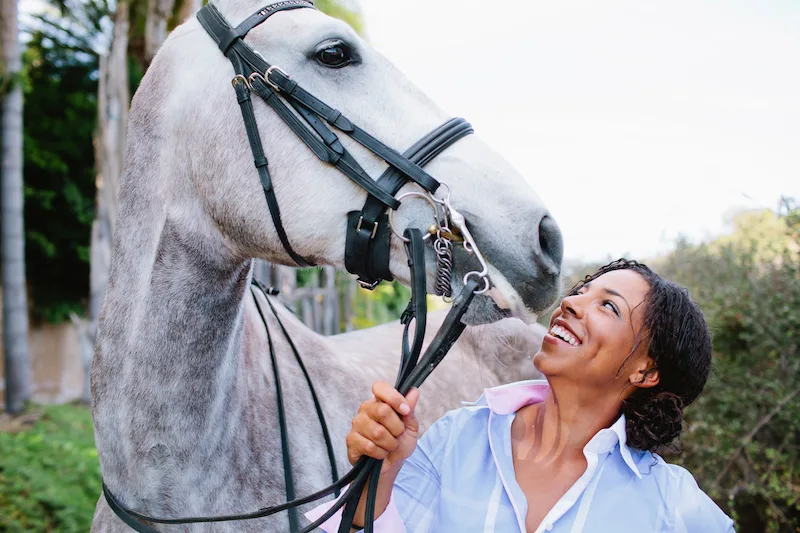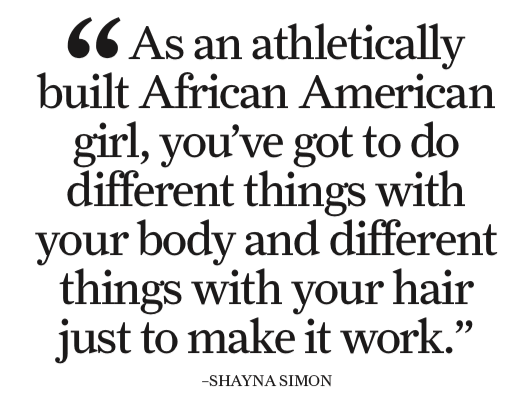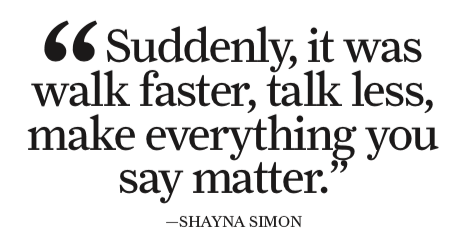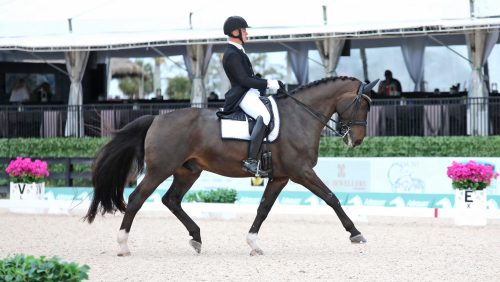This young professional has come a long way on her own merit, but she’s not arrived yet.
In 2017, Shayna Simon reached the pinnacle toward which dressage trainers around the United States aim—she qualified for the Dutta Corp. U.S. Festival of Champions in Gladstone, New Jersey, as one of the top 16 small tour combinations in the country. Not only that, but she did it riding her own gelding, Harley Davidson, whom she’s trained from a 3-year-old.
But Simon, 27, didn’t go to Gladstone. After her first full season showing in CDIs, she didn’t have the funds.

Shayna Simon knew from a young age that she wanted to make horses her life, and she’s pursued every opportunity that’s come her way as she worked toward that goal. Sydney Prather Photography photo.
“It was disappointing—not being able to financially support what I had achieved through years and years of work,” Simon said. “All I could think was that this was one of the biggest things I could have done in my life and with that horse. At the time, I was pretty upset about it.”
Deflated but undeterred, she kept plugging away at Arroyo Del Mar in San Diego, practicing the Grand Prix and hoping that if she and “Harley” qualify again, an unexpected door might open.
And she has good reason to hope. Making the most of every opportunity is a big part of what has gotten Simon where she is today.
Born To Ride
Simon learned to love horses on her grandfather’s Sacramento, California, farm, where for more than 30 years her mom’s side of the family had bred Peruvian Pasos. Her grandfather, Paul Simon, worked as a dentist, but he reserved two days a week for riding on the farm, and Shayna’s mom, Marni Simon, has fond memories of competing in multiple disciplines as a child.
“We joke that it took three generations to breed Shayna,” Marni said with a laugh. “We’ve all been doing this so long, but Shayna found a way to take it to a whole different level.”
Shayna’s ambition surfaced early. She began her first dressage lessons around age 7 with Colleen Reid at Blue Ribbon Stables. “It was all very demanding, and I loved that,” Shayna said. “I had to clean everything after every ride myself, and I was very organized. It meant more time at the barn, and that’s where I wanted to be.”
On weekends, Shayna and Marni would often drive to the nearby Murieta Equestrian Center in Rancho Murieta, California, to watch top riders compete in CDIs. Shayna watched videos of dressage masters throughout her youth, and a few times a year she and her grandfather would travel to Europe, stopping off to watch dressage masters train wherever they could.
When she turned 9, Shayna got her first dressage horse from DG Bar Ranch in Hanford, California, where she developed a lasting relationship with owners Tony and Betty DeGroot and head trainer Willy Arts.
“I went back to visit there all the time,” Shayna said. “I got to see Anky [van Grunsven] clinic as well as several [FEI five-star] judges. I got my first piece of international dressage there, and I knew, really from when I bought that first horse, that this was what I wanted to do professionally.” Thoroughly immersed in the dressage world, Shayna couldn’t help but notice, even as a child, that she was often the only person of color riding at the barn. But she doesn’t remember it bothering her.
“I grew up in a predominantly white community, so I think that’s part of why I’ve never been super uncomfortable with that aspect of it,” Shayna said. “I can see how others would be though, because a lot of the girls and guys that ride, they look the same—tall, thin, blond or brunette, basically European. Going in there as an athletically built African American girl, you’ve got to do different things with your body and different things with your hair just to make it work.
“I have to say, I don’t think I’ve ever let it be a negative though,” Shayna added. “I tried to look at it as, ‘Wow, I might get a little more attention and acknowledgement because I’m different—noticed in a good way.’ But then again, I still don’t see that many young black or Mexican or Asian kids riding, so I know that’s sometimes hard.”
Unlikely Opportunities
Until Shayna was 13, her mom and grandparents raised her in California, while her father was never really in the picture. But then Marni, who traveled a lot in her job as a software consultant, received an offer to work in Montana, far from the vibrant dressage community to which Shayna had grown accustomed.
It seemed like the end of her educational opportunities. But with a little creative thinking and a lot of support from her mother, Shayna transformed it into a new beginning.
“I made the decision with my mom to stay in California,” Shayna said. “There just wasn’t a lot of dressage in Montana, so I worked it out so that I could ride and live at DG Bar Ranch. I stayed with Marisa Phelps, who was a family member of one of the DeGroot daughters.”
Moving to DG Bar meant leaving family behind for the first time in Shayna’s life. But the decision made sense to Marni.
“Everything was always about the horses,” Marni remembered. “At 13, she made the call to do her own thing, move to a brand new place and a brand new school where she had no friends. She was on her own.”

Shayna Simon is used to the fact that the people who surround her in the dressage world— such as Olympians (from left) Steffen Peters, Guenter Seidel and Jan Ebeling—don’t look much like her, but she’s never let it bother her. “I tried to look at it as, ‘Wow, I might get a little more attention and acknowledgement because I’m different—noticed in a good way,’ ” she said. Terri Miller Photography photo.
Shayna didn’t remember feeling particularly homesick at DG Bar, where the DeGroot family warmly welcomed her. She attributes much of her growth as a dressage rider to DG Bar, where she spent two years in intensive training with Arts.
But as she approached her college years, her mom suggested a novel idea for furthering her daughter’s education via the University of Montana Western.
“They had an intercollegiate dressage association, and my mom told her friend who was an administrator how serious I was about riding,” Shayna said. “So someone from the college wrote a letter to some riders and trainers in Europe to see if I could do an internship in one of their programs, with the understanding that after that, I would continue my riding and training at the university.”
ADVERTISEMENT
Shayna distributed that letter far and wide. Along with it, she included a personal statement that began, “I don’t know if I walked or rode first.”
Unbeknownst to her, one of the recipients of that letter had penned the same phrase—David Collins, lead editor for several books written by German Olympic team gold medalist Klaus Balkenhol.
“That sentence was exactly how he started Klaus’ book,” Shayna said. “So they contacted me and said, ‘Honestly, Klaus doesn’t usually take Americans, but you can work for him because you’re clearly linked.’ ”
Shayna was elated to receive the call, but it took a trip to a local tack shop to punctuate the extent of her good fortune. Browsing for a new pair of breeches for her trip, Shayna spotted Klaus’ name on a magazine cover.
“I was so excited! I told the clerk, ‘Oh, I’m going there!’ ” Shayna said. “And she was like, ‘No, no you’re not. Do you even know who that is? He’s the U.S. team coach. You’re not going there.’ And I was like, ‘No way! I seriously am in like a week!’ But until then I actually had no idea who he was—I just knew he was a good trainer in Germany.”
At 16, Shayna boarded a plane bound for Germany to work for a man she had never met who spoke a language she didn’t understand. When her mom and grandfather dropped her at the airport, her grandfather offered one last piece of advice.
“He told her, ‘You can’t get in trouble if you have a broom in your hand,’ ” Marni remembered. “ ‘I don’t care if you just sweep—if you’re sweeping, if you’re always working, always doing something, you can’t get in trouble.’ ”
All Kinds Of Lessons
Shayna spent a year in Germany living and working with Klaus and Anabel Balkenhol. She traveled with them to shows, took lessons on their seasoned horses, and eventually reached the same conclusion that most Americans do after a little time riding dressage abroad.
“I basically learned that we don’t know anything here,” Shayna said with a laugh. “It really humbled me, because I was that kid who could get on horses and always just make it happen. Even when I had very little education, I just got on, and it worked. So when I went to Europe it was like, ‘Oh wow!’ It was all these different aspects of riding and the business of riding that I was totally unaware of.” At first, the difference felt intimidating. Marni remembered instant messaging with Shayna when she was in tears, worried about things like getting her wraps right or fitting in at the barn. But then she began to adapt.
“I had to mature quite a bit,” Shayna said. “When I got there, I was young, and I just did what young girls do—they say what they want to say, they act how they want to act, they walk how they want to walk. But suddenly, it was walk faster, talk less, make everything you say matter. And that was good. It sculpted me super quickly into who I wanted to be.
“Although, I do kind of wish I had still kept that more bubbly, buoyant part of me—more of that free-spirited girl I was—and somehow morphed that in with the positive things they helped me become,” Shayna added. “I kind of miss that girl sometimes.”
Shayna learned enough German to get by, riding in lessons primarily in English with Anabel and taking big- picture tips from Klaus in a mix of the two languages. By the end of her time there, Shayna had three to four rides a day, often sharing an arena with Olympic riders from around the globe.
But looking back, Shayna learned her greatest lesson not by watching the top riders who frequented the Balkenhol facility, but instead by looking just across the fence.
“A lot of the grooms and workers kept their horses next door,” Shayna said. “They would come get help with their not-very-talented horses who they were still somehow training to Grand Prix. Seeing them do that, riding and training every day, it taught me to be grateful for what you have and do the best you can. You don’t need to have a billion-dollar horse to be a great rider.”
A Less-Than-Billion-Dollar Horse
That lesson became Shayna’s mantra. At the end of her one-year tenure with the Balkenhols, Shayna’s mom and grandfather volunteered to purchase and import a horse for her, albeit on a budget.
Shayna immediately knew she wanted a young prospect, but Klaus had other ideas.
“Klaus was really against me getting a young horse because I was so young,” Shayna said. “Finally, after I said I’d be in training the whole time and that I realized I didn’t know enough to really train a horse on my own, he kind of agreed to look at a young horse with me.”
Harley was the third in a line of youngsters Shayna asked Klaus to evaluate. A 3-year-old Hanoverian (His Highness—Walt Lady, Walt Disney I), he had the athleticism and potential, and he seemed trainable enough for a young rider to bring along.

Shayna Simon qualified for the Dutta Corp. U.S. Festival of Champions at Intermediaire I aboard Harley Davidson, a horse she’s trained since he was 3, but she couldn’t afford to make the trip from her home in California to New Jersey. Terri Miller Photography photo.
Shayna returned to the United States with Harley. She spent two years at the University of Montana Western and then left school to work briefly in Colorado before settling at Brookside Equestrian Center in Walnut, California, one of the largest importers of Lusitanos on the West Coast.
She stayed there for four years, apprenticing under Stefan Wolf, a fellow Klaus student, before taking over the rides on his sales horses when he returned to Europe in 2013.
By that time, Harley’s easy demeanor had changed.
“Right when he turned 6 he just got really, really naughty,” Shayna said. “He bucked me off on Thanksgiving; he bucked me off on Christmas, every holiday it seemed like. It was horrible! I did not love him for a while.”
Advised by most trainers to sell, Shayna advertised Harley for 1 1⁄2 years but she found him too hot to move at a price commensurate with his talent. All the while, she continued taking him to shows, where scores confirmed that despite frustrations and frequent falls, the gelding was making progress.
ADVERTISEMENT
Among those to appreciate that progress was Guenter Seidel, with whom Shayna began riding while working at Brookside.
“He was quite a handful,” Seidel said. “Very explosive. You had to be quite an accomplished rider to even stay on at times. I remember she almost cleared the ring a few times. But she’s a very dedicated girl, especially for a young person. She always got around, and month by month, he got a little better.”
Finding Their Place
Harley never fully outgrew his explosive qualities. However, as the movements became more challenging around third and fourth level, that disruptive energy found an appropriate outlet.
“Finally, he started using his power for good,” Shayna joked. “When he made a turnaround, that was when I was like, ‘Oh, maybe I do want this type of horse after all!’ ”
Shayna left Brookside in 2015 to launch her own business. She was operating out of a private facility when she heard about an opening for another trainer at Arroyo Del Mar, home of Steffen and Shannon Peters.

Riding at the international level, it’s not just getting Riding Harley Davidson, Shayna Simon has finished second to her trainer, Steffen Peters (right), multiple times at different CDIs. Terri Miller Photography photo.
“I’d seen Shayna study with Klaus Balkenhol in Germany,” Steffen said. “I think both Klaus and I were equally impressed with Shayna even as a young person. The talent was quite obvious.”
The Peterses accepted Shayna’s bid, and she moved her horses and clients to Arroyo Del Mar. Like Seidel, Steffen immediately recog- nized the added challenge Shayna faced with Harley, who by that time was schooling Grand Prix.
“I’ve ridden Harley a bunch of times, and he’s certainly not an easy horse,” Steffen said. “Shayna’s done extremely well with him. At the end of the day you can have all the talent in the world, but if you don’t have the patience with horses like Harley, it simply doesn’t work. I’ve seen Shayna being extremely patient with Harley, and it’s a horse that will trust her because of this. And that’s always one of her biggest assets.”
Shayna and Harley thrived under the Peterses’ instruction. In the past two years, they’ve won a couple of small tour classes at CDIs and finished runner-up to Steffen multiple times, ranking as high as fifth nationally on the small tour.
But even at the highest level of competition, Shayna has found one last glass ceiling between her and her riding dreams.
“To go to these big shows, the expenses are a lot—like a lot a lot,” Shayna said. “Even when you buy your own young horse for a cheap amount, spend 10 years training it, do all the things you’re supposed to do, at the end of the day you still might not have the financial backing you need in order to attend these big competitions. Unfortunately the West Coast doesn’t have many CDIs, and now we’re all kind of being pushed to go to Florida to do the big shows and get the bigger sponsors, but for me that’s $30,000 for a month of riding.
“I think people just aren’t aware that riding at the international level, it’s not just getting there—it’s being able to survive once you’re there,” Shayna added. “And you can only really survive with quite a bit of financial backing.”
Her mentors have seen more than a few riders reach the same point as Shayna and fail to push through. But they agree that only one thing breaks the barrier—winning enough to attract the sponsors and supporters to fill in the financial gap.
“We always have to show the result first and then look for some support; it usually doesn’t work the other way around,” Steffen said. “All of us, including myself, have to prove ourselves, especially in the CDI Grand Prix arena, and then once the results are black and white certainly there are lots of sponsorship possibilities as far as grants from our federation and from private people.
“That’s another great character trait for Shayna,” Steffen added. “Because she knows that’s how it goes. She knew she needed to be a winner outside the show arena first, and now she knows she has to bring in the results. And I think she’s clearly on her way to doing so.”
Despite the disappointment of missing Gladstone in 2017, Shayna knows that in the big picture, simply qualifying stands as an accomplishment. As she and Harley ride out this season at Grand Prix, she’s still deciding what comes next. As always, she’s considering every option—from trying to make it to Florida through a GoFundMe campaign, to going back to Europe, to syndicating or even selling Harley.
And wherever the next door opens, she’s poised and ready to go through.
“I think in six months I’ll know more of what avenue I want to go,” Shayna said with a laugh. “I got Harley when I was 16, and I certainly never expected him to be an international large tour horse. For now, my goal is to get to the Grand Prix CDI ring and do the best I can, and see if I can financially support us through that or not.
“I have a bunch of ideas on my mind, but the most important thing is still just the training,” Shayna added. “The money concerns are there, but to get that daily training out of Steffen and Shannon and everyone else who helps us—that is priceless.”
This article appeared in the June 4 & 11, 2018, issue of The Chronicle of the Horse.
You can subscribe and get online access to a digital version and then enjoy a year of The Chronicle of the Horse and our lifestyle publication, Untacked. Or you can purchase a single issue or subscribe on a mobile device through our app The Chronicle of the Horse LLC.
If you’re just following COTH online, you’re missing so much great unique content. Each print issue of the Chronicle is full of in-depth competition news, fascinating features, probing looks at issues within the sports of hunter/jumper, eventing and dressage, and stunning photography.
What are you missing if you don’t subscribe?

















